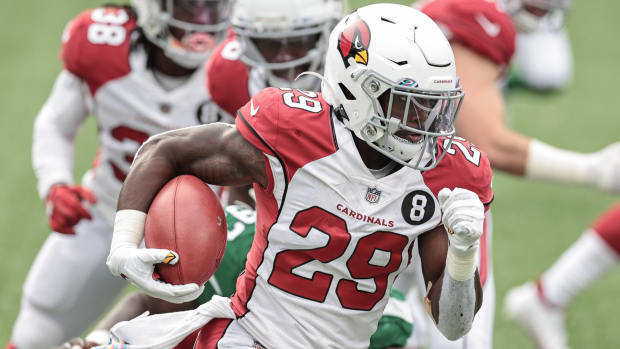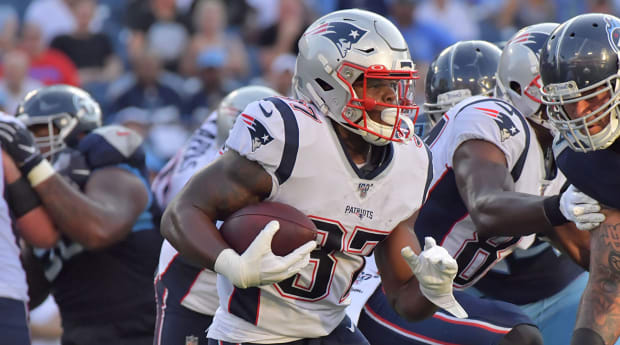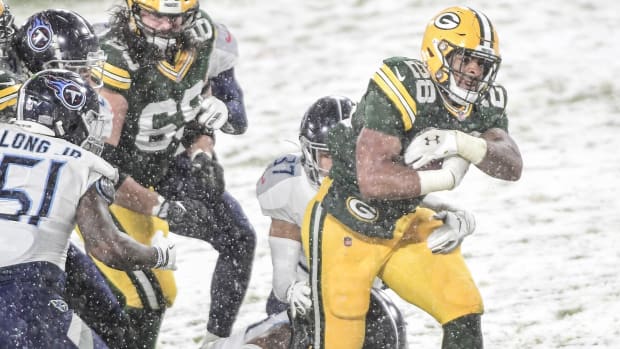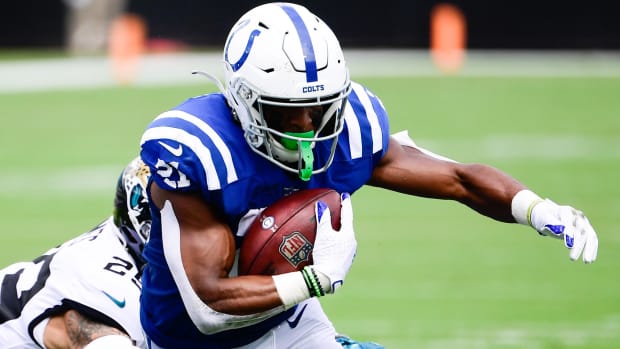New on Sports Illustrated: Fantasy Football ADP: Backup Running Backs Breakdown
A closer look at fantasy football's backup running backs draft value, potential, average draft position and outlook for the 2021 NFL season
There is a mixed bag of pass-catching options and grinders with some touchdown value in this group of running backs. Most fantasy owners will select their RB3 between the sixth and eighth rounds. It is almost impossible to win fantasy football without depth at the running back position. In most seasons, an impact running back will emerge from this area of the draft. Finding him on draft day comes down to identifying a higher floor with a pass-catching back or a running back option that may land a full-time job after an injury.
ADP Breakdowns
RB3 (Ranked 25th to 36th)

In the RB3 group of running backs, a fantasy owner is trying to find a player that can score enough fantasy points to cover an injury or bye week plus still have underlying upside. A runner with early-down value will need to score a touchdown to produce double-digit fantasy points in most weeks. A pass-catching back can have fewer touches but finish with more consistency in fantasy points in PPR leagues.
Here’s an example of three type backs in this area:
Early-down back with minimal pass-catching value
If a running back gets between 10 and 15 rushes per game, he’ll finish with between 40 yards and 75 yards in most weeks. As I mention early with no touchdown, this type of player will score below 10 fantasy points unless he breaks a long run.
Passing catching back with minimal value on early downs
The top fantasy owners in the high-stakes market tend to gravitate toward pass-catching backs when developing their secondary core at running back. A running back who catches about four passes per game will gain between 7.5 and 10.0 yards per catch leading to seven to eight fantasy points in PPR leagues. If they get about a half dozen carries in a game, this type of running back can reach double-digit fantasy points without scoring a TD or hitting on a long play. If they do score, it tends to push them toward low-RB1 status for that week.
Backup RB with starter upside
This type of running back is the most frustrating player to own if forced to start due to an injury or bye week. With minimal touches, backup running backs will score almost no fantasy points until they gain starting status. Ideally, a fantasy owner would like to take these types of shots at RB5 and RB6, with some coming as handcuffs.
Top Pass-Catching RB3s
Kareem Hunt, Cleveland Browns
If given a starting job, Hunt would be a top-12 back. He delivered a dominating year (1,882 combined yards with 11 touchdowns and 53 catches) in his rookie season before seeing his career sidetracked with an off-the-field issue in 2018. Last year, he had more touches (236) than expect on early downs, with Nick Chubb missing four games. Hunt fell short of expectations in the passing game (38/304/5) after setting a higher bar in 2019 (37/285/1) over eight matchups.
Cleveland wants to use him on one-third of their plays on early downs, pointing to 8 to 10 rushes in most games. He remains the top choice on passing downs while also getting some chances in the run game at the goal line.
Hunt projects well as a playable fantasy player with a high ceiling if Chubb had an injury. For me, he sets the bar to beat when looking to roster your third running back after the middle of round five in PPR leagues. His early ADP sits as 62 in the 12-team higher stakes market.
Chase Edmonds, Arizona Cardinals

© Vincent Carchietta-USA TODAY Sports
As the RB2 for the Cardinals in 2020, Edmonds worked as the pass-catching back (53/402/4) while averaging about six rushes per game. His role/opportunity should improve slightly this year with James Connor added to the roster and Kenyan Drake moving onto the Raiders. However, Arizona gave him only one rush inside the five-yard line in 2020. There is upside in Edmonds game and Connor tents to get injured. For owners punting RB2 in PPR leagues with a wide receiver strong build, Edmonds should be their target in the seventh to eighth round (ADP – 72).
James Robinson, Jacksonville Jaguars
There won't be many times when a 21-year-old rookie running back gains over 1,400 combined yards with 10 scores and 49 catches in his rookie season, and he loses his starting job the following year. Robinson falls in the pass-catching back category based on his success in 2020, but Travis Etienne offers much more explosiveness while earning raves in training camp about his ability in the passing game. As a result, Robinson will get 10 to 12 touches a game while being a more challenging player to start in fantasy leagues.
Melvin Gordon, Denver Broncos
With Denver adding a talented rookie running back in this year’s draft class, Gordon should slide to a split role on early downs while seeing a rebound in his chances on passing downs. He finished with 58 catches in 2017 over a full season with the Chargers, followed by 50 catches in 12 starts the next year. Many fantasy owners have passed the baton to Javonte Williams, but Gordon remains a serviceable player with a favorable ADP (94).
Potential Breakouts
Javonte Williams, Denver Broncos
With Melvin Gordon still in the mix at running back for the Broncos, I couldn’t give Williams the total breakout tag. His training camp reports have been positive, which is reflected by his ADP (64). In college, North Carolina used him as a split role with Michael Carter. Williams offered big-play and scoring ability while showing growth as a receiver. My early thought is that he will be in a 50/50 split on early downs with possibly one-third of the pass-catching chances. However, if Gordon has an injury, his floor moves to RB2 status.
Michael Carter, New York Jets
The path for Carter to win a starting running back job looks more projectable than Javonte Williams. New York doesn’t have anyone blocking him, but their offense looks like a work in progress. Carter brings explosiveness with improving experience in the passing game (25/135/1, 21/154/2, and 25/267/2). His price point (ADP – 74) screams value. To offer a higher ceiling, Zack Wilson needs to hit the ground running.
Upside Running Back Options
Trey Sermon, San Francisco 49ers
The 49ers’ offense features the running back position, and their receiver corps adds the firepower to rank highly in scoring. Sermon had a short resume in college (2,549 combined yards with 21 touchdowns and 32 catches) over 32 games while doing the most damage in 2020 over eight games (965 combined yards with four touchdowns and 12 catches). Raheem Mostert stands in his way, but he does have injury risk while never receiving more than 151 touches in a season at age 28. Sermon looks attractive, but I would be careful not to overprice him.
Zack Moss, Buffalo Bills
The Bills want Moss to be their lead running back. However, he remains in a split role with Devin Singletary while facing competition for rushing touchdowns with Josh Allen. I don’t expect impact catches, pushing him into the steady category.
Stuck in Neutral
Damien Harris, New England Patriots

Jim Brown-USA TODAY Sports
Heading into the 2019 NFL Draft, I had Harris as my top running back in that class. After an empty rookie season (4/12) due to injuries, he flashed over 10 games (137/691/2) while missing the first three and final three games. Unfortunately, New England won’t give him a clean ride for starting snaps, and James White remains the third-down passing catching back. If Cam Newton starts, score touchdowns at the goal line with be challenging for Harris. He has upside, but I can’t buy him as his current ADP (81). Harris fits more the RB4 role until he carves out a more significant role in the Patriots’ offense.
Split Backfield Decisions
Ronald Jones & Leonard Fournette, Tampa Bay Buccaneers
Both players helped Tampa win the Super Bowl last year.
Fournette has the better pedigree (fourth overall selection in 2017) while entering the season at age 26. Over the final four games, with Jones not at 100 percent, he gained 448 combined yards with four touchdowns and 18 catches or 21.7 fantasy points per game in PPR leagues. He missed three games in the regular season, with emptiness in five games (five fantasy points or fewer). Ideally, The Bucs would like him to do the dirty work on third downs, plus be on the field for about 35 percent of their runs.
Jones flashed from Week 4 to Week 6 (374 combined yards with two touchdowns and 11 catches) while adding an impact game (23/192/1) in Week 10. His yards per rush (5.1) graded well, and he scored over 10.00 fantasy points in 10 of his 14 games.
My lean is toward Jones, but I could see Fournette having a similar role in the Bucs’ offense as Kareen Hunt with Cleveland.
RB4 (Ranked 37th to 48th)

Each fantasy football season, multiple running backs emerge as starters after an injury. The best way to cut the legs of another team is by stealing their RB1 handcuff.
For any following Chad Schroeder in fantasy football, he wrote the script for cheating RB2. The plan is simple, but one must understand the player pool and the drop-offs in tiers at each position while being on the clock for less than 90 seconds.
The best path to victory starts with an impact running back with three-down ability. Then, over the next few rounds in the draft, acquiring elite wideouts set the stage for minimal decision-making in your lineup while adding consistency and explosiveness to your fantasy roster. If a separator tight end, a la Trevis Kelce, falls at the right price, he creates an edge while almost being treated as a WR1 or WR2, depending on that player’s expected return in stats.
Without giving away all the trade secrets, I’ll jump back to the RB2 position. After about round 8, a team with an edge lead running back and a foundation at wide receiver begin to draft high upside handcuffs after the next few rounds. The goal is to strengthen your RB2 position as the season moves on, leading to an explosive roster late in the year when league titles and overall championships are won.
Best Ceiling Handcuffs
AJ Dillon, Green Bay Packers

Benny Sieu/USA TODAY Sports
The Packers expect Dillon to take over the Jamaal Williams role in their offense, but his skill set isn’t the same. He brings power to the run game, giving Dillon a chance to snipe Aaron Jones at the goal line. His value in the passing game looks minimal. If awarded with the starting job after an injury, Dillon would offer a similar style of play as Derrick Henry. Green Bay will get him involved in their game plan, helping his playable value if needed to start to cover an injury or bye week.
Tony Pollard, Dallas Cowboys
In his second season, Pollard saw his touches reach 129, leading to 628 combined yards with five touchdowns and 28 catches. However, he remains the second running back fiddle in Dallas, awaiting an injury to Ezekiel Elliott to strut his stuff. His ceiling looks high, leading to him being sniped by non-Elliot owners with the hopes of him turning into a home run or being used as an RB2 matchup player.
Alexander Mattison, Minnesota Vikings
In 2020, Mattison was a challenging handcuff to own for Dalvin Cook owners due to his eighth-round ADP. However, this season, he consistently slides to the end of the 10th round (ADP – 128), making him easier to lock up for the wise Cook owners. Additionally, Mattison has the foundation skill set to play on all three downs, pointing to RB1 upside if Cook went down with a length injury. The Vikings typically don’t give him enough touches each week to deliver playable stats, making Mattison a buy-and-hold type investment. If I invest Cook, I’m coming away from the draft with his handcuff.
Outside the Box
David Johnson, Houston Texans
Over the past couple of weeks, Johnson has been free-falling in drafts (current ADP – 101). The whole offensive situation in Houston remains cloudy until the ball drops on Deshaun Watson’s season. The Texans brought in two other backs to compete for playing time despite Johnson finishing with a good season in 2020 (1,005 combined yards with eight scores and 33 catches) over 12 games. He gained 4.7 yards per carry and 9.5 yards per catch.
If Houston wants to move on from him, Johnson would be a viable upgrade to the running back depth on the Rams. No one has mentioned him in a trade, so I’m speculating on a possibly better situation to earn his keep.
Pass-Catching Traps
Nyheim Hines, Indianapolis Colts

© Douglas DeFelice-USA TODAY Sports
Over his first three seasons with the Colts, Hines has 170 catches for 1,227 yards and six touchdowns, which works out to 3.5 catches for 26 yards and 0.13 scores per game. The improvement in his opportunity in the run game (89/380/3) in 2020 came from an injury to Marlon Mack. Indy eased Jonathan Taylor into his rookie campaign, but that won’t be the case this year. Taylor played well in the passing game (36/299/1 on 39 targets), earning him more looks out of the backfield this year. Hines will get chances in some games, but his overall stats project much lower in 2021. I view him more as a semi-handcuff to Taylor.
J.D. McKissic, Washington Football Team
The recent coach-speak out of Washington is that they want to use Antonio Gibson similarly as the Panthers feature Christian McCaffrey. Some may write this off as fluff, but their coaching staff developed McCaffrey. Gibson has the tools to play on all three downs, which would be doom for the chances for McKissic. His ADP (131) prices him low enough to be disposable if Washington doesn’t use him on passing downs. If Gibson had an injury, McKissic would not see an every-down opportunity for the long haul.
RB3 & RB4 ADP Final Thoughts
The back-half of the running inventory looks weak or unidentifiable, pushing many fantasy owners to take their fifth running back dance after the 12th round.
When reviewing the running back ADPs, a fantasy owner can see the potential backs of interest. Each draft will have a wide range of results, so a targeted backend running back may not fall as far as expected. Decision-making in drafts comes down to tradeoffs at each position.
- If I take player A at running back, will the wide receiver I want slide to me in the next round?
- Should I move up a wide receiver knowing the running back I like isn’t drawing a ton of interest in other drafts?
- If I reach on a running back and move him up a round in the draft, what are the comparable options at wide receiver available if I miss on the wide receiver I targeted earlier in the draft?
These are the types of thoughts that should occur before the draft to help speed up your decision-making when on the clock.
Drafting a winning fantasy team is full of timely decisions and weak moments when waiting for a player of interest to slide to your draft pick. Building a foundation of running backs takes some foresight while also giving up some passion for possible edges at quarterback, wide receiver, and tight end. In the end, your success will come down to your draft plan, style of play, and ultimately some luck.
More Fantasy & Gambling:
- Players Falling on Draft Day
- QB Rankings: Passing Yards Player Prop Projections
- Standouts Climbing Draft Boards
- Draft Strategies: First Six Picks Drafting 9th to 12th
- 2021 Fantasy Football Comeback Player of the Year
- 2021 Highest-Scoring NFL Team by the Odds
Senior analyst Shawn Childs is a multi-sport, high-stakes fantasy legend with lifetime earnings in the high six-figures. He has been providing in-depth, analytical break downs for years all while helping his subscribers to countless titles and winnings across season-long & DFS. A inaugural inductee of the NFBC Hall of Fame, Shawn can teach you how to prep like a champ!








No comments